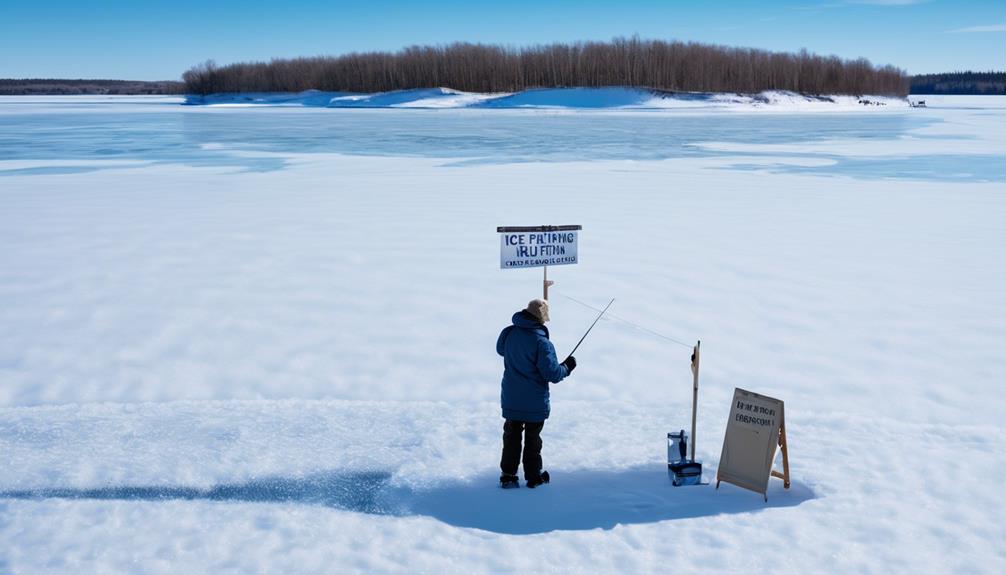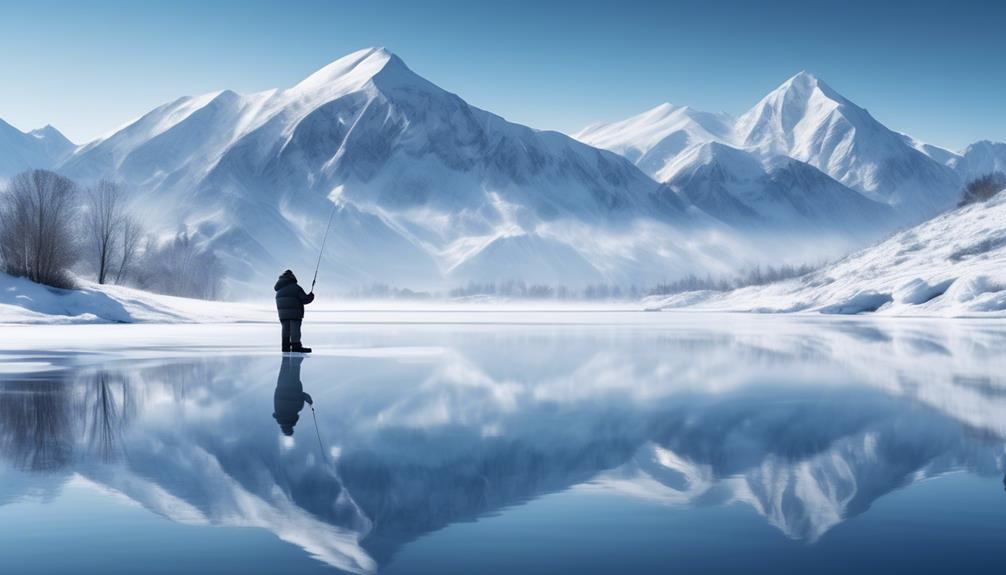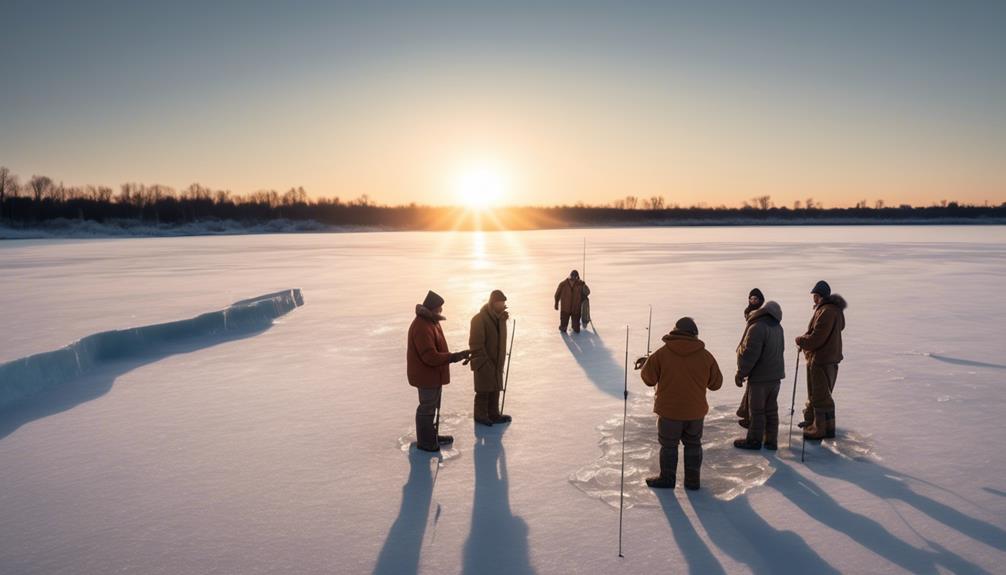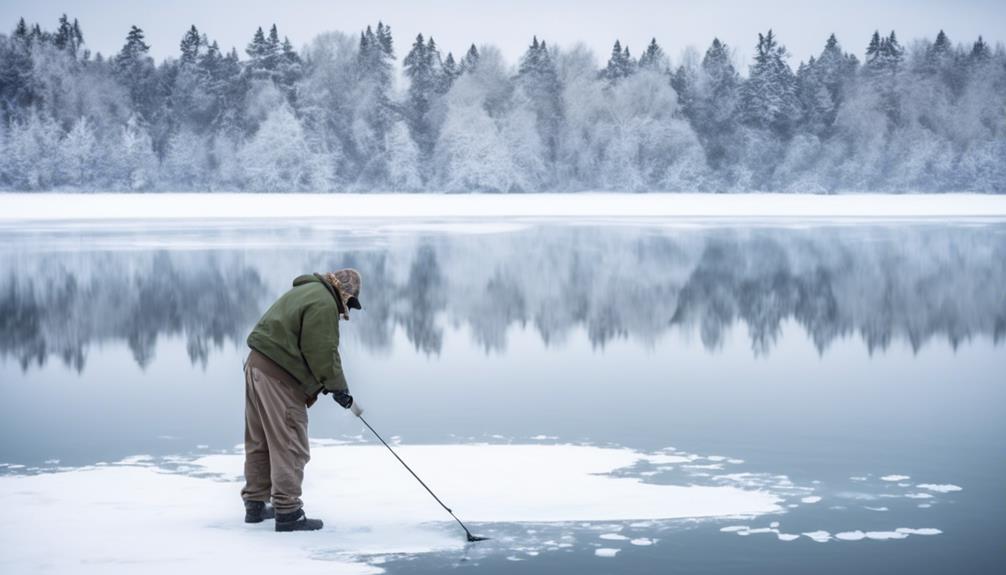Imagine standing on the edge of a vast, frozen lake, the stillness broken only by the sound of your breath in the crisp, cold air.
You've chosen to pursue the elusive northern pike, known for its strength and cunning.
As you prepare to venture onto the ice, there are crucial tips and techniques that can make the difference between a successful catch and a frustrating day.
From understanding pike behavior to selecting the right gear and mastering effective ice fishing techniques, the secrets to catching northern pike in deep lakes await.
Understanding Northern Pike Behavior
Have you ever wondered how Northern Pike behave in deep lakes and what strategies you can use to catch them? Understanding their movement and feeding patterns is crucial for a successful pike fishing expedition. Northern Pike are known for their ambush hunting style. They often lurk in submerged vegetation or near underwater structures, waiting for prey to pass by. In deep lakes, pike tend to follow the forage fish, such as perch or walleye, which also seek out deep, cool waters during the warmer months. When hunting, pike exhibit short bursts of incredible speed, allowing them to swiftly strike and capture their prey. Knowing these movement patterns can help you target the areas where pike are likely to be present.
Feeding patterns of Northern Pike are influenced by various factors, including water temperature and light conditions. In deep lakes, pike may move to shallower areas during low-light conditions, such as early morning or evening, to feed. They're visually-oriented predators, so they often rely on sight to hunt. This means that using brightly colored lures or bait can be effective, especially in clear waters. Additionally, pike are known to exhibit cannibalistic tendencies, preying on smaller pike. Understanding these feeding patterns can aid in selecting the appropriate lures or bait and determining the best times for fishing.
Essential Gear for Deep Lake Ice Fishing
Understanding the movement and feeding patterns of Northern Pike in deep lakes is essential for successful ice fishing expeditions. Equally important is having the right gear to ensure a productive and safe ice fishing experience.
When preparing for deep lake ice fishing, it's crucial to ensure that your gear is in top condition. Before heading out, thoroughly inspect your ice fishing equipment to ensure it's free from damage and in good working order. This includes checking your ice auger, fishing rods, reels, and tip-ups for any signs of wear and tear. Proper gear maintenance will help prevent any unexpected malfunctions while out on the ice.
When it comes to deep lake ice fishing, having the right gear can make all the difference. Consider investing in an ice auger with sharp blades to easily drill through thick ice. Additionally, a sturdy and reliable fishing rod and reel are essential for battling Northern Pike in deep waters. Make sure your line is strong and abrasion-resistant to handle the powerful fights that Northern Pike are known for. Tip-ups equipped with sensitive triggers are also valuable tools for targeting Northern Pike in deep lakes.
As for ice fishing techniques, employing depth finders and underwater cameras can significantly improve your chances of locating Northern Pike in deep waters. These tools can help you identify potential hotspots and adjust your fishing strategy accordingly. Understanding the behavior of Northern Pike and adapting your techniques to deep lake conditions will greatly enhance your ice fishing success.
Identifying Prime Ice Fishing Locations
To increase your chances of catching Northern Pike in deep lakes during ice fishing, pinpointing prime locations is crucial for success. Identifying the best spots to set up your ice fishing gear can significantly improve your chances of a successful catch. Here are some key tips for identifying prime ice fishing locations:
- Depth Mapping: Utilize depth mapping technology to identify areas of the lake with varying depths. Northern Pike are often found in deeper waters, so focusing on areas with depths of 10-20 feet or more can be productive.
- Underwater Structures: Look for underwater structures such as submerged reefs, rocky points, and drop-offs. These areas often attract Northern Pike as they provide cover and ambush points for hunting prey.
- Weed Beds: Locate areas with dense underwater vegetation, as these serve as prime feeding and breeding grounds for Northern Pike. Pay close attention to areas where the weed beds transition into deeper water.
- Inlet and Outlet Channels: Inlet and outlet channels can be hotspots for Northern Pike, especially during the winter months. These areas can concentrate fish as they move in search of food and oxygenated water.
- Bait Fish Presence: Keep an eye out for signs of bait fish activity. Northern Pike are predatory fish and are often found in areas where their prey congregates.
Effective Bait and Lure Selection
When targeting Northern Pike in deep lakes during ice fishing, selecting the right bait and lures becomes essential for enticing these elusive predators to strike. Bait presentation is crucial when luring Northern Pike. Using large minnows or dead baitfish, such as smelt or ciscoes, on tip-ups can effectively attract these predatory fish. Ensure that the baitfish is lively and swimming freely to mimic natural movement, which can trigger a pike's predatory instinct. For jigging, consider using soft plastic swimbaits or spoons with erratic action to imitate injured prey, enticing Northern Pike to strike.
Lure retrieval is another key factor in catching Northern Pike. Varying your retrieval speed and depth can help determine the most effective approach. Experiment with fast and erratic retrieves to trigger aggressive strikes from pike, especially in deeper waters. Additionally, incorporating pauses and sudden changes in direction during retrieval can mimic the behavior of wounded prey, making your lure more appealing to these apex predators.
When it comes to bait color and lure size, consider the water clarity and light conditions. In murky or stained waters, bright and flashy lures with contrasting colors can grab the attention of Northern Pike. Conversely, in clear waters, natural and more subdued bait colors may yield better results. Select larger lures when targeting trophy-sized pike, as they're more likely to go after substantial prey. Conversely, smaller lures can be effective for targeting smaller pike or when the fish are less active. Remember to adjust your bait and lure selection based on the specific conditions of the deep lake you're fishing in.
Techniques for Ice Fishing Northern Pike
Consider using tip-ups strategically placed at varying depths to increase your chances of catching Northern Pike during ice fishing excursions. When targeting Northern Pike under the ice, understanding their movement patterns and employing the right ice fishing techniques can make all the difference. Here are some key tips to help you successfully catch Northern Pike:
- Varying Depths: Set up tip-ups at different depths to cover a range of the water column, as Northern Pike are known to patrol various depths, especially near drop-offs and underwater structures.
- Live Bait: Implement live bait such as large shiners or suckers to entice Northern Pike, as their predatory nature makes them highly responsive to live baitfish.
- Aggressive Jigging: Use aggressive jigging motions to attract the attention of Northern Pike, as they're drawn to the erratic movements of prey.
- Tip-Up Setup: Ensure your tip-ups are set with a sensitive trigger mechanism to promptly alert you when a Northern Pike takes the bait, allowing for a timely response.
- Patience and Observation: Exercise patience and closely monitor the tip-ups for subtle movements, as Northern Pike may initially inspect the bait before committing to a strike.
Safety Precautions for Deep Lake Ice Fishing
For safe ice fishing in deep lakes, always ensure that the ice is thick enough to support your weight before venturing onto it. Safety precautions are essential when engaging in this thrilling activity. Before heading out, make sure to pack essential safety equipment such as ice picks, a throw rope, and a personal flotation device. These items could potentially save your life in the event of an emergency.
Additionally, it's crucial to inform someone of your plans and location before starting your ice fishing expedition. In the unfortunate event of falling through the ice, having someone aware of your whereabouts can significantly expedite the emergency response. It's also important to regularly check the weather and ice conditions, as these can change rapidly and dramatically affect the safety of the ice.
Emergency procedures should be familiar to all members of your ice fishing group. Ensure that everyone knows how to respond in case of an emergency, including how to use the safety equipment. Practice using the ice picks and throwing the rope to someone on the ice to simulate a rescue scenario.
Lastly, always be cautious and never take unnecessary risks. Deep lake ice fishing can be an incredibly rewarding experience, but safety should always be the top priority. By following these safety precautions and being prepared for emergencies, you can enjoy your ice fishing adventure with peace of mind.
Understanding Ice Fishing Regulations

Before embarking on your ice fishing expedition, it's important to familiarize yourself with the regulations governing ice fishing, ensuring that you comply with all necessary rules and restrictions for a safe and enjoyable experience. Understanding ice fishing regulations is crucial for preserving the natural environment and ensuring the sustainability of fish populations.
Here are some essential points to consider:
- Legal Requirements: Familiarize yourself with the specific ice fishing regulations for the area you plan to fish in. This includes knowing the legal fishing season, size and bag limits, and any restricted areas.
- Proper Permits: Ensure that you have the appropriate fishing license for ice fishing. Different locations may have varying permit requirements, so it's essential to obtain the correct permits before heading out onto the ice.
- Conservation Efforts: Be aware of any conservation efforts in place, such as catch-and-release policies or specific regulations aimed at protecting certain species. It's important to adhere to these guidelines to support sustainable fishing practices.
- Environmental Impact: Understand the potential environmental impact of ice fishing and take steps to minimize any negative effects. This includes properly disposing of waste and being mindful of the surroundings.
- Compliance: Always follow the regulations and guidelines set forth by the local authorities. Compliance with these rules not only ensures a legal and ethical fishing experience but also contributes to the overall conservation of fish populations and their habitats.
Winterizing Your Ice Fishing Equipment
Ensure your ice fishing equipment is well-prepared for the colder temperatures by winterizing it properly. When it comes to storing your equipment during the off-season, it's essential to prevent rust and corrosion.
Start by thoroughly cleaning and drying all your gear before putting it away. Remove any bait from your tackle, and make sure to wipe down your rods, reels, and other metal components with a cloth or towel to remove any moisture that could lead to rust. Additionally, consider using a rust-preventative spray on metal parts to provide an extra layer of protection.
Properly storing your ice fishing equipment is crucial for maintaining its quality. Keep your rods and reels in a cool, dry place to prevent any moisture buildup, which can lead to rust over time. Storing your gear in a protective case or bag can also help shield it from potential damage and corrosion.
If you have any fabric components, such as ice fishing shelters or tents, make sure they're completely dry before storing them to prevent mold and mildew growth.
Frequently Asked Questions
What Are Some Common Mistakes That Ice Fishermen Make When Trying to Catch Northern Pike in Deep Lakes?
When ice fishing for Northern Pike in deep lakes, common mistakes include improper lure selection and not using proper equipment. Improve your technique by researching the best lures and ensuring you have the right gear.
Are There Any Specific Strategies for Targeting Larger Northern Pike in Deep Lakes?
To target trophy pike in deep lakes, focus on deep water tactics. Use large lures and fish near drop-offs and points. Vary your retrieval speed to entice strikes. When you spot a big one, cast accurately and reel in confidently.
How Does the Behavior of Northern Pike Change in Deep Lakes Compared to Shallow Lakes During the Winter?
In deep lakes during winter, northern pike's behavior changes, and their feeding habits adapt. They tend to move to deeper, more oxygenated waters, and become less active, making it important to adjust your fishing tactics accordingly.
What Is the Best Way to Handle and Release a Northern Pike After It Has Been Caught?
When handling and releasing a northern pike, gently support its body, keep it in the water, and avoid removing protective slime. Ice fishing tip: Use a jaw spreader and long-nose pliers for an easier release.
Are There Any Unique Challenges or Considerations When Ice Fishing for Northern Pike in Deep Lakes Compared to Other Species of Fish?
When ice fishing for northern pike in deep lakes, unique challenges arise compared to other species. Consider ice fishing considerations specific to deep lake pike fishing, like the need for specialized gear and understanding pike behavior in deep waters.
Conclusion
So, now that you have all the tips and tricks for catching northern pike in deep lakes, it's time to get out there and give it a try!
Remember to stay safe, use the right gear, and follow regulations.
With the right knowledge and preparation, you'll be well on your way to reeling in some impressive northern pike during your next ice fishing adventure.
Good luck!



